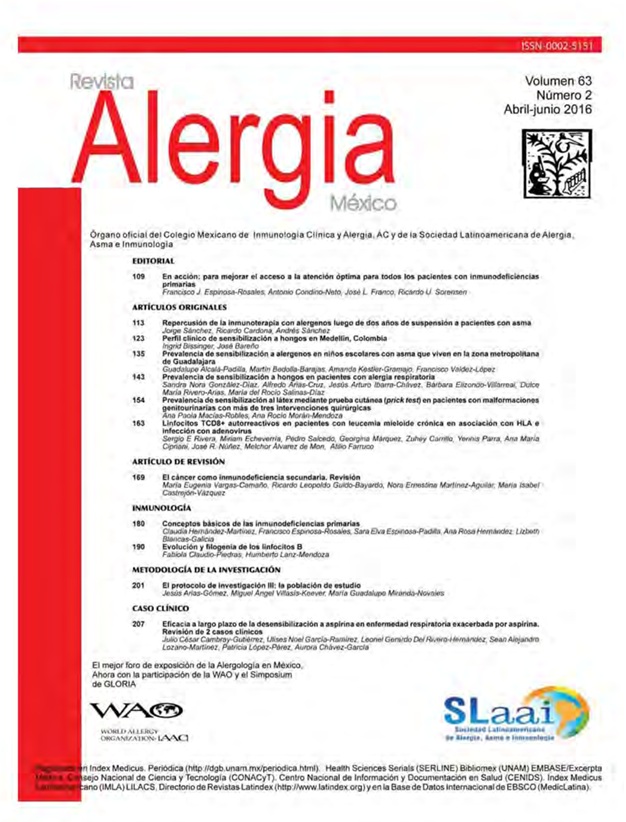Abstract
Background: Latex allergy is a public health issue. It presents elevated prevalence in known risk groups, especially in those patients with spine bifida condition, urinal malformation and for those with orthopedic problems - multiple surgeries. Health Services in Mexico do not have the enough studies about prevalence and risk associated to latex allergy.
Objective: Determine latex sensitization prevalence through PRICK test in patients with genitourinary malformations and more than 3 surgeries in UMAE pediatric CMNO unit, considering too related factors.
Material and method: An analytical and descriptive cross-sectional study was performed, which included men and women from 1 to 16 years with genitourinary malformations and more than three surgeries. A survey to know the risk factors associated and prick test was performed with latex extract, with positive and negative control. Serum levels of total IgE and eosinophils were measured in peripheral blood.
Results: The study exposed prevalence of 30.72%. Related to associated factors as follows: atopy (p=0.047), previous antecedent reaction to latex products (p=0.003) specific for balloons (p=0.000) and gloves (p=0.002). There was not association related to amount of surgeries and surgical interventions on early age, either for high levels of total serum IgE.
Conclusion: Prevalence to latex sensitization is high in risk groups. Especially in those with atopy thereby is important for health personal to identify these patients in order to implement on time the preventive primary/secondary measures. With these actions potential mortal risks like anaphylaxis will be avoided. This will decrease sanitary costs and mortality.
References
Slater JE. Latex allergy. En: Kay AB, ed. Allergy and allergic diseases. Oxford: Blackwell Science: 1997;981-93.
Cabañes N. Latex Allergy: Position Paper. J Invest Allergol Clin Immunol. 2012;22(5):313-330.
Stern G. Uberempfindlichkeit gegen kaustchuk als urasche von Urticaria and quinckeschemodem. Klin Wochenschrift. 1927;6:1096-7.
Nutter AF. Contact urticaria to rubber. Br J Dermatol. 1979;101:597-8.
Kahn SL, Podjasek JO, Dimitropoulos VA, Brown CW Jr. Natural rubber latex allergy. Dis Mon. 2016;62(1):5-17.
Liss GM, Sussman GL. Latex sensitization: occupational versus general population prevalence rates. Am J Ind Med. 1999;35:196-200.
Negro Alvarez JM, Miralles López JC. Alergia al látex. Rev Clin Esp. 2003;34;2;28-35.
Blanco C. Latex-fruit syndrome. Curr Allergy Asthma Rep 2003;3:47-53.
Thompson RL. Educational challenges of latex protein allergy. Immunol Allergy Clin North Am. 1995;15:159-74.
Ausili E, Tabacco F, Focarelli B, Nucera E, Patriarca G, Rendeli C. Prevalence of latex allergy in spina bifida: genetic and environmental risk factors. Eur Rev Med Pharmacol Sci. 2007;11(3):149-153.
Pires G, Morais-Almeida M, Gaspar A, Godinho N, Calado E, Abreu-Nogueira J. Risk factors for latex sensitization in children with spina bifida. Allergol et Immunopathol. 2002;30(1):5-13.
Yassin MS, Sanyurah, Fischer TJ. Evaluation of latex allergy in patients with meningomyelocele. Ann Allergy 1992;69(3):207-11 .
Kattan H., Har H.A., Tipirneni P. Latex allergy in Saudi children with spina bifida. Allergy. 1999;54:70-3.
Buck D, Michael T, Wahn U, Niggemann B. Ventricular shunts and the prevalence of sensitization and clinically relevant allergy to latex in patients with spina bifida. Pediatr Allergy Immunol. 2000;11:111-5.
Kelly KJ, Pearson ML, Kurup VP, Havens PL, Byrd RS, Setlock, et al. Acluster of anaphylactic reactions in children with spina bifida during general anesthesia: epidemiologic features, risk factors and latex hypersensitivity. J Allergy Clin Immunol. 1994;94(1):53-61.
Eiwegger T, Dehlink E, Schwindt J, Pomberger G, Reider N, Frigo E, Rokitansky AM, Urbanek R, Szépfalusi Z. Early exposure to latex products mediates latex sensitization in spina bifida but not in other diseases with comparable latex exposure rates. Clin Exp Allergy. 2006;36(10):1242-6.
Turjanmaa K. Diagnosis of latex allergy. Allergy. 2001;56:810-2.
Bueno de Sá A, Faria Camilo Araujo, Cavalheiro S, Carvalho Mallozi. Profile of latex sensitization and allergies in children and adolescents with myelomeningocele in Sao Paulo, Brazil. J Invest Allergol Clin Immunol. 2013;23(1):43-49.
Michael T, Niggemann B, Moers A, Seidel U. Risk factors for latex allergy in patients with spina bifida. Clinical and Experimental Allergy, 1996;26:934-9.
García JC, Moyano JC, Álvarez M, Bellido J. Latex allergy in fruit-allergic patients. Allergy. 1998;53:532-6.
Castor J. Rau R, The Harriet Lane Handbook. 19 ed. Mosby- Elsevier, 2012;395.

This work is licensed under a Creative Commons Attribution-NonCommercial 4.0 International License.
Copyright (c) 2016 Revista Alergia México

